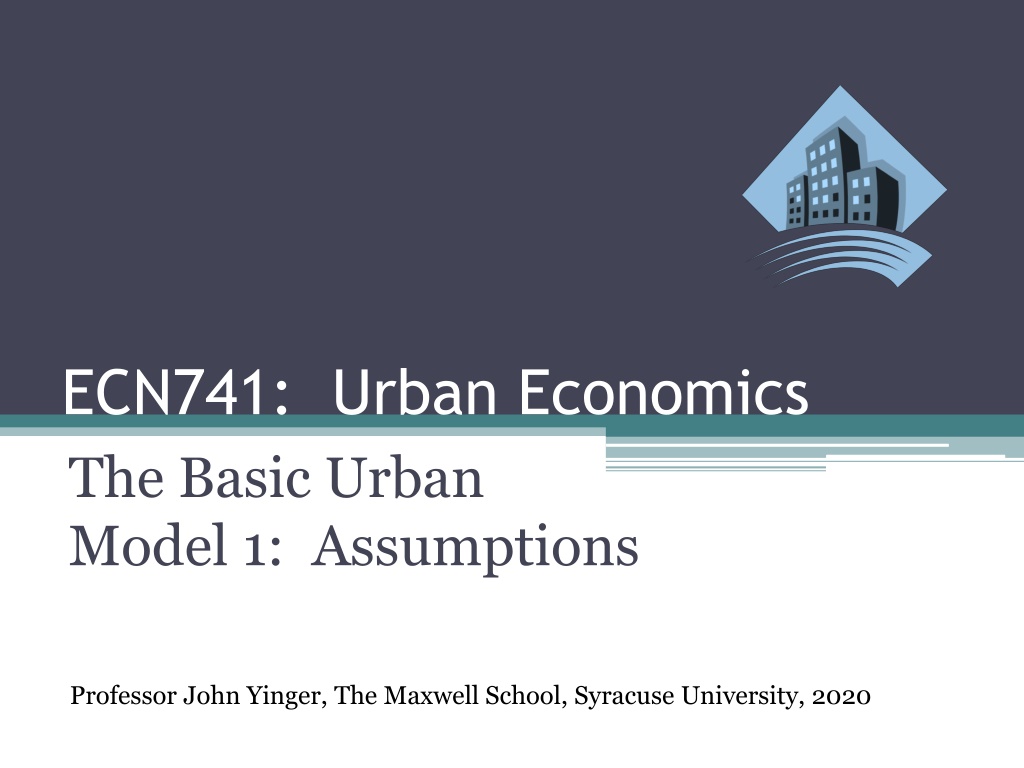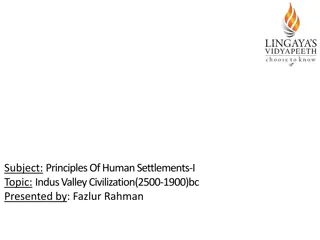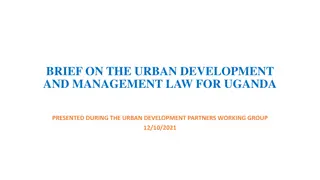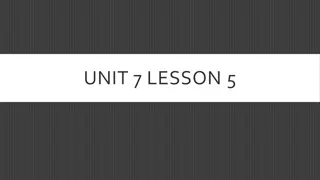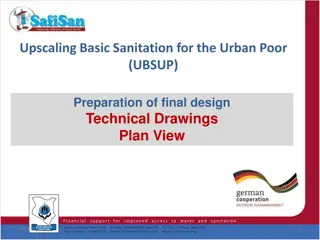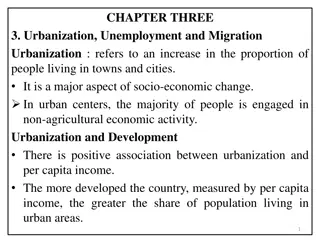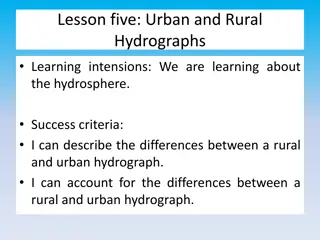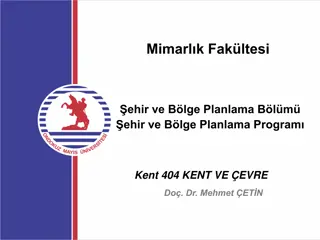The Basic Urban Model - Origins and Key Concepts
The Basic Urban Model originates from German economist Johann Heinrich von Thünen, focusing on bidding and sorting in urban economics. It examines how activities sort across locations based on land bids and transportation costs to a central market. The model illustrates rent variations for different activities at varying distances from the market.
Download Presentation

Please find below an Image/Link to download the presentation.
The content on the website is provided AS IS for your information and personal use only. It may not be sold, licensed, or shared on other websites without obtaining consent from the author. Download presentation by click this link. If you encounter any issues during the download, it is possible that the publisher has removed the file from their server.
E N D
Presentation Transcript
ECN741: Urban Economics The Basic Urban Model 1: Assumptions Professor John Yinger, The Maxwell School, Syracuse University, 2020
The Basic Urban Model Class Outline 1. Origins of Urban Economics 2. Key Assumptions of a Basic Urban Model 3. The Basic Household Maximization Problem with Residential Location Choice 4. The Urban Model Twist
The Basic Urban Model Class Outline 1. Origins of Urban Economics 2. Key Assumptions of a Basic Urban Model 3. The Basic Household Maximization Problem with Residential Location Choice 4. The Urban Model Twist
The Basic Urban Model von Th nen Urban economics was invented (sort of) by a German agricultural economist, Johann Heinrich von Th nen, who lived from 1783 to 1850. More specifically, von Th nen invented the concepts of bidding and sorting, which form the basis for urban economics. He also, by the way, invented general equilibrium analysis! (Samuelson, JEL, December 1983)
The Basic Urban Model von Th nen s Model von Th nen modeled the location of agricultural activities around a central market place. Each activity had a maximum amount it was willing to pay for land at each location its land bid. The winning activity at a given location was the one that bid the most there. This leads to the sorting of activities across locations.
The Basic Urban Model von Th nen s Model, Continued The key to the model is transportation costs, based on straight-line travel to the market. Some firms produced heavy or perishable products, so they would not pay much for land far from the center; transportation costs would eat up all their profits at distant locations. But some other factors, based on von Th nen s practical knowledge of agriculture, also came into the model.
The Basic Urban Model von Th nen's Model of Rents and Locations Annual Rent per Acre 0 2 4 6 8 10 12 14 16 18 20 Milk Wood Grain Livestock City Rent for Milk/Vegetables Rent for Wood Rent for Grain Rent for Livestock Distance from Central Market (miles) This figure draws on Grotewold, Economic Geography 1959.
The Basic Urban Model Alonso In 1964, William Alonso published Location and Land Use, based on his dissertation in regional planning. This amazing book applied the von Th nen logic to the location of households in an urban area. People all work in a central work site. Each type of household bids on land in every location. Household types sorted into different locations based on their bids, and types with steeper bid functions locate nearer to the center. Alonso also anticipated many future developments in urban models.
The Basic Urban Model Mills and Muth Edwin Mills (at Princeton and thesis adviser to many urban economists, including B. Hamilton, W. Fischel, P. Courant, M. White, J. Yinger, A. O Sullivan, K-H. Kim) and Richard Muth (at Chicago) extended Alonso to consider housing at about the same time. Mills: A 1967 publication (May AER), which cites a Muth working paper; a 1972 book (Studies in the Structure of the Urban Economy). Muth: A 1969 book (Cities and Housing).
The Basic Urban Model Class Outline 1. Origins of Urban Economics 2. Key Assumptions of a Basic Urban Model 3. The Basic Household Maximization Problem with Residential Location Choice 4. The Urban Model Twist
The Basic Urban Model Urban Models Urban models are designed to explain why urban areas look the way they do, with a focus on housing. Where do people live? How far do they commute? How much housing do they consume? What is the price of housing?
The Basic Urban Model Key Assumptions We now turn to the key assumptions of a basic urban model. These assumptions lead to a simple, complete urban model that describes urban residential structure After we explore a model with these assumptions, this class will investigate how urban residential structure changes when more general assumptions are introduced.
The Basic Urban Model Key Assumptions 1. Housing Demand 2. Housing Supply 3. The Transportation Network 4. Why Location Matters 5. Types of Households 6. The Labor Market 7. Household Mobility 8. Local Governments
The Basic Urban Model 1. Housing Demand Housing demand functions are derived from household utility functions that depend on a composite consumption good, Z, and housing, H, and take the Cobb-Douglas form. (1 )ln{ } U Z = + ln{ }, H H is measured in units of housing services = quality- adjusted square feet. This problem has a time dimension, say, one year.
The Basic Urban Model 2. Housing Supply Housing services are produced with land, L, and capital, K, according to a Cobb-Douglas production function with constant returns to scale. 1 a = a H K L Housing is owned by absentee landlords. Maintenance, rehabilitation, and conversion activities are ignored; construction labor is ignored; this is a long-run model.
The Basic Urban Model 3. The Transportation Network Households commute between place of residence and place of work (= the central business district, CBD). To approximate commuting costs, the model assumes: The urban area is located on a featureless plain (=von Th nen!). People commute (approximately, at least) in a straight line; there are no commuting arteries or street grids. Commuting costs per mile, t, are constant. There is only one transportation mode (=car?)
The Basic Urban Model 4. Why Location Matters Distance to work is the only locational characteristic households care about. This assumption rules out neighborhood amenities, such as School quality, Access to shopping or recreation, Air quality, or The characteristics of their neighbors.
The Basic Urban Model 5. Types of Households All households are alike. All households have the same income, family structure, job location, and utility function!!! We obviously need to weaken this assumption and eventually we will.
The Basic Urban Model 6. The Labor Market Income is fixed and all households have a single worker with a job in the CBD. This assumption greatly limits labor market analysis: There is no explicit export good (and hence no explicit derived demand for labor). The implicit demand curve for labor is horizontal.
The Basic Urban Model 7. Household Mobility Households are assumed to be perfectly mobile within an urban area. If a household has an opportunity to improve its utility, it will take it! This assumption implies that all (identical!) households will achieve the same level of utility and is crucial to the logic of urban models.
The Basic Urban Model 8. No Local Governments The basic urban model ignores local governments. There are no local government services and no property taxes. This is obviously and important omissions, and we will spend a third of the class trying to fix it!
The Basic Urban Model Questions What are the key assumptions in a simple urban model? Which assumptions seem most unrealistic?
The Basic Urban Model Class Outline 1. Origins of Urban Economics 2. Key Assumptions of a Basic Urban Model 3. The Basic Household Maximization Problem with Residential Location Choice 4. The Urban Model Twist
The Basic Urban Model Preliminaries Now to set up the basic household problem that is the core of an urban model, we consider The price of housing, Owning versus renting, and Specifying commuting costs. Throughout these notes, brackets, { and }, are used to indicate the arguments of a function, whereas parentheses and braces, ( and ) plus [ and ], are used to clarify the algebra.
The Basic Urban Model The Price of Housing The annual price per unit of housing services is P. This price depends on household location, measured in miles from the CBD, u; that is, P = P{u}. Apartment rent (= annual housing cost) is P{u}H. The derivative of P with respect to u, is assumed to be negative (an assumption that will later be derived): P {u} = dP{u}/du < 0
The Basic Urban Model Owner-Occupied Housing This model can also be applied to owners. The value of a house, V, is the present value of the rental benefits from owning it. Let ibe a household s real discount rate and M be the expected lifetime of a house in years. Then ( ) 1 1 y i + P u H { } P u H i { } P u H i M = = V y * = where i + = * . i ( ) M 1 1 i
The Basic Urban Model Note on Discount Rates Note that i*can be thought of as the infinite horizon discount rate ; that is, it is the discount rate under the assumption of an infinite horizon equivalent to the actual discount rate with the actual horizon, M. In the case of housing, the actual horizon is large, so there is not much difference between i and i*. Thus, we can use the simple version of the formula.
The Basic Urban Model Specifying Commuting Costs Commuting costs add the spatial dimension to a basic urban model. We will look more closely at commuting in later classes, but a standard treatment recognizes both the operating costs and the time costs of commuting. One common formulation of round-trip cost per mile is: t t = + t Y 0 Y where t0 = round trip operating costs per mile per year, tY = value of one hour of commuting time as a fraction of the hourly wage times two divided by commuting speed, and Y = annual income.
The Basic Urban Model The Household Problem The household problem is to Maximize U{Z, H} Subject to Y = Z + P{u}H + tu The Lagrangian is ( ) P u H = + , , U Z H Y Z tu
The Basic Urban Model The First-Order Conditions The key first-order conditions are: = U Z = 0, Z U H P u = = 0, H ( ) P u H = + = 0. t u
The Basic Urban Model Implications The first two conditions imply that / / U U H Z P u = . MRS MB , H Z H This is a standard result: A household sets the marginal rate of substitution between H and Z equal to their price ratio. Because Z is the numeraire with a price of 1, the MRS is equivalent to the marginal benefit of H in dollar terms, MBH.
The Basic Urban Model Implications, 2 The third condition is unique to urban models. It indicates that a household moves away from the CBD until it finds the u* at which the savings in housing costs from moving 1 mile further out equals the associated increased commuting cost: * P u = H t
The Basic Urban Model Location Choice $ -P {u}H t u* u
The Basic Urban Model A Puzzle Can you see a problem with this result? Every household is alike, so every household picks the same u*. Question: How can we have a city in which everyone lives the same distance from the CBD? Answer: We can t!
The Basic Urban Model Class Outline 1. Origins of Urban Economics 2. Key Assumptions of a Basic Urban Model 3. The Basic Household Maximization Problem with Residential Location Choice 4. The Urban Model Twist
The Basic Urban Model The Urban Model Twist The key to solving this puzzle is to recognize that the form of P{u} is determined by the market. Hence, the equation for a household s location choice can be interpreted as a equilibrium condition for P{u}, that is, as a locational equilibrium condition. If P{u} meets this condition, then every household will be satisfied no matter where it lives and no household will have an incentive to move.
The Basic Urban Model The Locational Equilibrium Condition The locational equilibrium condition is written: t P u = . H Because t and H are positive, the slope of P{u} must be negative. (The earlier assumption is now proven.) Econ 101 tells us that H declines with P, so the slope must get flatter as u increases.
The Basic Urban Model The Bid Function for Housing (Price per Unit of Housing Services) P{u} Slope = P/ u = -t/H P u u CBD
The Basic Urban Model Features of Equilibrium 1. The model does not say where any given household will live. Location choices are now idiosyncratic and outside the model. 2. The locational equilibrium condition defines a family of bid functions. Higher bid functions correspond to a higher cost of living and a lower utility level.
The Basic Urban Model A Family of Bid Functions P{u} Lower Utility u CBD
The Basic Urban Model Questions What is the intuition behind the urban model twist? What are the implications of the urban model twist for the nature of equilibrium in an urban housing market?
The Basic Urban Model Looking Ahead Next time we will see how this household problem fits into equations for the other markets in an urban area. The result is a general equilibrium model of urban residential structure. This model sets the height of the bid function, as well as its slope.
